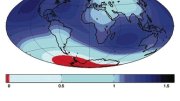In the popular imagination, sea levels rise in response to a warming climate in the same way water rises in a bathtub when the tap is turned on: evenly and uniformly around the globe.
Until nine years ago, many scientists also assumed the same thing. That’s when professor of geophysics Jerry X. Mitrovica (then at the University of Toronto) and collaborators including Harvard College Observatory associate James L. Davis reported in Nature that incorporating glaciers’ gravitational pull into the equations used to describe sea-level changes would help explain the extreme variation scientists were already seeing around the world. The equations then in wide use accurately described the trend in average sea level worldwide—a rise of about two millimeters per year in the twentieth century—but couldn’t explain why actual observed conditions in many places did not conform to that average. Nevertheless, as long as the observed average rise was consistent with their equations, scientists tended to ignore the outliers, recalls Mitrovica (mi-tro-VI-tsa). “We were saying, ‘Those are really important.’”
In fact, some places on Earth could find the local sea level falling. This is because the sheer mass of glaciers generates gravitational pull and draws water closer, raising the sea level nearby. As glaciers melt, though, this pull weakens and the adjacent sea level falls. At locations far from a given glacier, the most noticeable effect of its melting will indeed be the increased volume that meltwater has added to the sea; closer in, though, decreased gravitational pull becomes the predominant effect.
In a 2009 Science paper, Mitrovica and collaborators including doctoral student Natalya Gomez presented a “fingerprint” of future polar ice-sheet collapse.
Much depends on which ice sheets melt. If glaciers near only one pole collapsed entirely and those near the other pole didn’t melt much, the gravitational effects (and resulting sea-level drop) would be concentrated at that end of the world; if glaciers near both poles melted, sea levels at high latitudes would fall, while seas near the equator would rise at a much greater rate than the global average.
If only the Greenland Ice Sheet melted, sea levels would fall along the shores of Scotland, and the Netherlands would see only one-fifth the average sea-level rise worldwide. (“Of course, that’s what they’re hoping for, even as they plan for the worst-case scenario,” says Mitrovica. “But if you’re Australian, you have a very different hope.”)
Conversely, if the West Antarctic Ice Sheet melted and Greenland’s did not, “Tierra del Fuego on the southern tip of Chile might see sea levels fall,” says Mitrovica. This wouldn’t affect many local human residents—the Antarctic glacier is far from populated areas—but the United States might find itself in hot water. In all locations far from the Antarctic ice sheet—that is, in most of the Northern Hemisphere—sea levels would rise more than average, and more than older models have predicted.
But that’s not all. When glaciers melt, the redistribution of their mass causes changes in the earth’s rotational axis. “The earth isn’t a perfect sphere,” Mitrovica explains. “It’s flattened because it’s rotating. If you move the pole, the flattening adjusts.” If the West Antarctic sheet collapsed, the pole would move such that sea levels would rise even more in North America. If this ice sheet—but none of the others—were to collapse, water levels at Boston, Washington, D.C., and other sites along the east and west coasts of the United States would rise 30 percent more than the global average. Given a worldwide average rise of 5 meters in sea level, these cities would face seas higher by 6.5 meters.
Alarming though these projections may be, they are not immediate. “We’re talking a scale of hundreds of years before this could ever happen,” says Mitrovica. Predictions of what will happen are not his bailiwick; he leaves that to climate scientists and focuses instead on what he compares to “detective work.” He and others working on the same problem start with the equivalent of four “fingerprints” all laid down atop each other: they know how much sea levels have risen during the past century—or in some cases, several centuries—at various inhabited locations. From these observed changes, their work is to isolate the distinct impact—the individual fingerprint—of the melting of the West Antarctic Ice Sheet; the Greenland Ice Sheet; other glacier systems including that in Alaska; and thermal expansion (the seas’ increasing volume as temperatures rise, an effect that would fade into the background if glacial melt, with its more severe effects, were to speed up). In this way, they are able to make an indirect observation of precisely how much volume and mass each ice sheet has lost. These calculations aid predictions of how the process will unfold in the years to come.
In climate science and throughout earth and planetary science, these “fingerprints” and the complex mathematical methods behind them have gained wide acceptance. But even now, when Mitrovica talks with scientists from other fields about the finding that sea levels will fall in some places, he is reminded that the idea is “so counterintuitive that sometimes they don’t believe it. Or they think it must be dependent on some weird model parameter. But it isn’t. It’s just Newton sitting under the tree and the apple hitting him on the head.”









